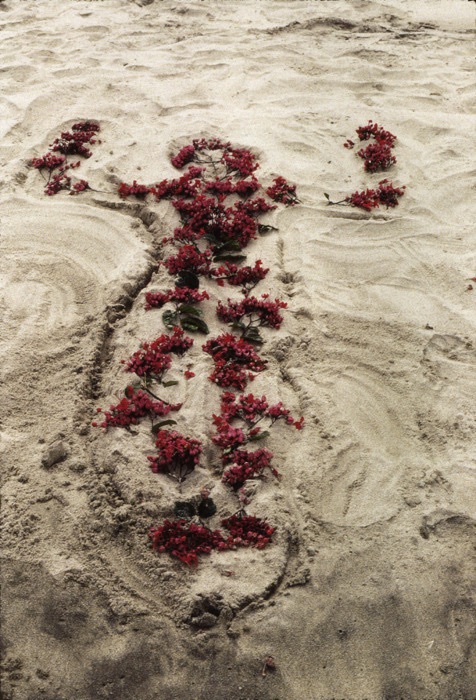The Cuban-American artist Ana Mendieta (1948-85) is known for her performance art, ‘earth-body sculptures’, photographs and video work, much of which centred on her own body. She was born in Havana, but during the political upheaveals of the early 1960s, she and her sister (along with many Cuban children) were sent to the United States under ‘Operation Peter Pan’, ending up in an orphanage. This dramatic exile, separating her (at age thirteen) from family and homeland, had a formative influence on her art.
Mendieta’s haunting ‘Siluetas’ (1973–81) are among her most powerful works, a fusion of performance and earth art. In these untitled sculptures, Mendieta burnt, dug or otherwise shaped her own silhouette into different outdoor sites. Often she filled in the silhouette with ephemeral materials – flowers, twigs, leaves, fire, gunpowder, candles. Sometimes her body itself, covered with flowers or mud, formed the silhouette. Interested in the earth as a site to address feelings of displacement, she recorded the presence of her body – or the imprint it left – within various environments.
In a 1981 statement about the work, she wrote: “I have been carrying out a dialogue between the landscape and the female body (based on my own silhouette). I believe this has been a direct result of my having been torn from my homeland (Cuba) during my adolescence. I am overwhelmed by the feeling of having been cast from the womb (nature). My art is the way I re-establish the bonds that unite me to the universe … Through my earth-body sculptures I become an extension of nature and nature becomes an extension of my body.”
The Silueta works – about a hundred in total – were performed as she traveled between her home in Iowa and Mexico during the period 1973-81. As the sculptures were transitory, the documenting photographs and films are considered the artworks.
In the photographs, red flowers or red powder glow against sand, soil or stone; flames burn against the earth. Mendieta drew on knowledge about indigenous rituals and beliefs, including the deities (orishas) of the Afro-Cuban religion of Santería. One beach sculpture consists of red bouganvillea blossoms in the shape of the artist’s body with arms raised; another shows incoming waves covering the silhouette on the sand. For those familiar with Santeria, the symbolism is apparent: Chango, a principal orisha, is represented by the colour red; his mistress, Yemaya, is orisha of the ocean – the frothy white waves represent her lacy petticoats.
Mendieta died in 1985 when she mysteriously fell from a 34-storey building at the age of 36, just as her work was becoming recognised outside the specialised world of feminist art criticism. Her Silueta series in particular remains a powerful body of work, an evocative testament to the effects of displacement and to the importance for this artist of an emotional connection to nature.





